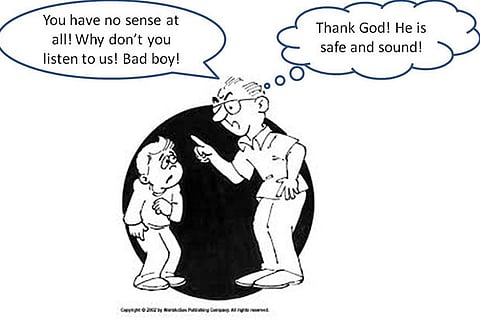

Chennai
DHRUV, 5 years old, went missing in a crowded mall. His parents were frightened and worried. They started searching for him frantically, praying he was safe and unharmed. When the parents found Dhruv they started scolding him “Do you have any sense? You never listen to us, next time we will not get you to a mall!”
Amulya, 20 years old, had got her driving license recently. She went out with her friends for a movie and happened to get very delayed. The tensed and terrified parents were livid with her when she returned home and ended up speaking to her quite harshly. In both the situations, the parents were justified being fearful, worried and concerned for their children’s safety and well-being. But by expressing only their anger, unfortunately those feelings of concern and care did not reach their children.
Aren’t we all conditioned to react this way? When we are stressed or upset about something we may experience big feelings such as fright, anxiety, worry or concern (all these are primary feelings) which lead to us having the secondary feeling of anger. Often, anger gets expressed violently, leaving the primary feelings unexpressed. It is commonly believed in our society, that only if we are tough on our children or shout at them will they learn to be responsible.
Is this really true? Today, research indicates that a hormone called the Cortisol is released in the brain when one is under stress. Cortisol floods the brain and suspends logical thinking and decision-making powers. So, when we punish or scream at our children with the intention to teach them, ironically no learning is happening! In fact, we may notice our children making the same mistake over and over again and end up either being fearful or rebellious. A reprimanded child may end up thinking “Amma does not understand me. Or Appa wants only to get his own way.
He does not care about my side of the story. There is no use talking to them. Let them shout, I will do whatever I like.” Instead, if we could communicate our primary feelings, “I was terrified, when I could not find you. I am so relieved to see you safe.”
Or “It worries me when you return home late. I wish you could just call me to let me know when you are held up.” Expressing our primary feelings makes children aware of our fears and concerns instead of feeling attacked or feeling disapproval. They realise where the parent is coming from, and this prompts children to be responsible and cooperate.
Communicating our primary feelings is a non-blaming and respectful way of expressing feelings. It ensures connection between parent and child facilitating learning in children. Identifying and communicating our primary feelings takes some practise. As shared in our earlier articles, we as parents need to take a pause when we are angry and upset, connect with our own feelings, then regulate ourselves with self-empathy.
Only then can we be available to our children. Our role as parents is to guide our children, to be around for them whenever they need us. For us to be approachable, we need to share a strong bond and connection with our children. Communication is the key to deepening and cultivating that bond.
The writer is a certified parent educator with Parenting Matters, an organisation which empowers parents to build deeper connection in families. To know more, look us up www.parentingmatters.in
Visit news.dtnext.in to explore our interactive epaper!
Download the DT Next app for more exciting features!
Click here for iOS
Click here for Android